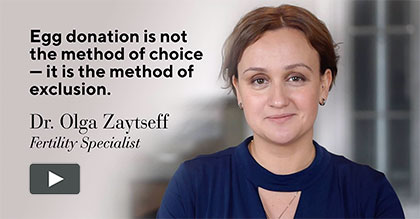After egg donation (or embryo adoption), the day X has finally come and you receive the most awaited and joyful news ever — you are pregnant! Of course, you are on сloud nine with happiness!
But here is the question that suddenly comes to your head: “Is my egg donation pregnancy special and does it differ from naturally conceived pregnancies?”
The answer is both yes and no.
Indeed, your pregnancy after egg donation (embryo adoption) is special because:
- Pregnancy after egg donation still needs external hormonal support, especially until the end of 12th week
- Women pregnant after egg donation might experience bleeding due to the change in hormonal level
- After egg donation, you need to be less active than usual and keep a relaxed lifestyle
- Your way towards this pregnancy hasn’t been easy and it still feels very delicate and even surreal
However, your pregnancy after egg donation (embryo adoption) is all the way natural because:
- Your chances for the live birth after egg donation are the same as for young women using their own eggs
- The probability of a miscarriage after egg donation is low and is the same as for young women pregnant with their own eggs
- This egg donation pregnancy couldn’t have happened without you and your strong wish to have this child
- There is now life inside you that you are responsible for and feel an immediate connection with!
It is important to know the particularities of pregnancy after egg donation (embryo adoption) so that everything develops well and your pregnancy brings you only the joy of motherhood. You will discuss these special aspects in every detail during your individual consultation with the nurse in our clinic.
The main information to consider when pregnant after egg donation:
Your chances of giving birth after egg donation Hormonal status in the first trimester after egg donation Possible bleeding in the first trimester after egg donation Measures to reduce the miscarriage risk after egg donation
Your chances of giving birth after egg donation
Women of advanced reproductive age, unfortunately, have low chances of creating a pregnancy with their own eggs and carrying it to the full term mainly due to egg quality that dramatically decreases after the age of 40. Luckily, the alternative of using donor eggs or donor embryo restores your chances to the level of 25-year-old and helps you become pregnant and have a healthy child soon.
By looking at two graphs below you will see that the live birth rates for women who went through embryo adoption or egg donation are the same as for women under the age of 30 years old who use their own eggs. Moreover, the risk of miscarriage after egg donation (or embryo adoption) is much lower compared to the own egg pregnancies in women above 40 years old. All this is due to the low incidence of chromosome abnormalities in younger eggs that are used for the treatment.
Live birth rates by age
for egg donation and own egg IVF
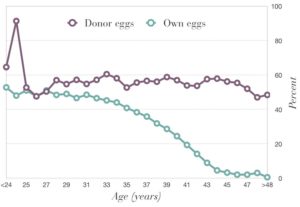
Percentages of Transfers That Resulted in Live Births for Assisted Reproductive Technology (ART) Cycles Using Fresh Embryos from Own Eggs and ART Cycles Using Fresh Embryos from Donor Eggs, by Age of Woman, 2009. Reference: American national summary on assisted reproductive technology success rates, National Center for Chronic Disease Prevention and Health Promotion, December 2011. (Data from 84 039 embryo transfers with fresh non-donor eggs and 16 225 embryo transfers with fresh donor eggs)
Miscarriage rates for women
using their own eggs in IVF treatment
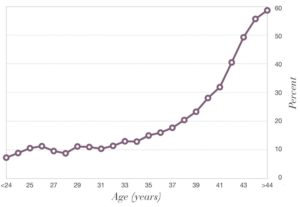
Percentages of IVF Cycles Using Fresh Non-donor Eggs or Embryos That Resulted in Miscarriage, by Age of Woman, 2009
Reference: American national summary on assisted reproductive technology success rates. National Center for Chronic Disease Prevention and Health Promotion, December 2011
So, all in all, by using donor eggs/donor embryos women of advanced reproductive age get exactly the same chances of the live birth as young women using their own eggs!
Hormonal status in the first trimester of pregnancy after egg donation
The two hormones responsible for a steady development of any pregnancy are estrogen and progesterone. Their growing levels ensure that there is no monthly bleeding and that your pregnancy is preserved.
Own egg pregnancy
If we look at an own egg pregnancy, during its first 12 weeks progesterone and estrogen are generated by a "corpus lutheum" (or ‘yellow body”) in an ovary. This corpus lutheum is the remains of an ovulated follicle. An embryo regulates levels of estrogen and progesterone by its own hormone called Human Chorionic Gonadotrophin (HCG). The higher HCG levels — the higher the levels of estrogen and progesterone. The role of growing estrogen and progesterone concentrations is in delaying menstruation and keeping the lining inside the uterus.
Embryo or egg donation pregnancy
Yet, in an embryo or egg donation pregnancy there were no eggs created by the recipient’s ovary. On the contrary, woman’s ovaries have been sleeping in this cycle and haven’t produced any follicles at all. This leads to the situation that, there is no corpus lutheum in an ovary and hence — no own estrogen/progesterone production even there an embryo present in the uterus that produces HCG. That is why in the first 12 weeks it is vital for a woman to take external progesterone and estrogen to imitate the function of the corpus lutheum and to keep their levels high. After the full 12 weeks of pregnancy the placenta takes charge of the progesterone and estrogen production. The placenta originates form embryonic cells and hence is present in all kinds of pregnancies, maintaining them no matter how they were created.
Embryo-maternal dialogue in the first trimester of naturally conceived pregnancy
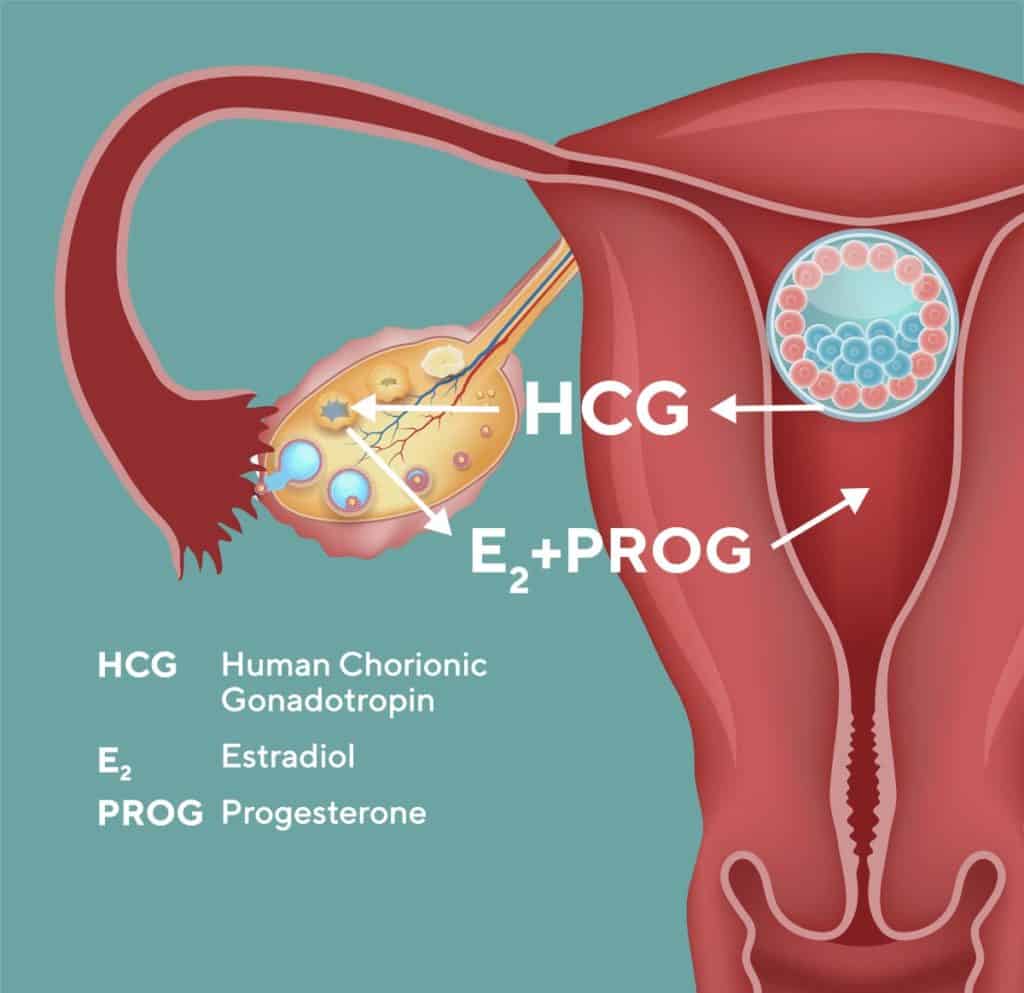
Different embryo-maternal dialogue in the first trimester of egg donation pregnancy
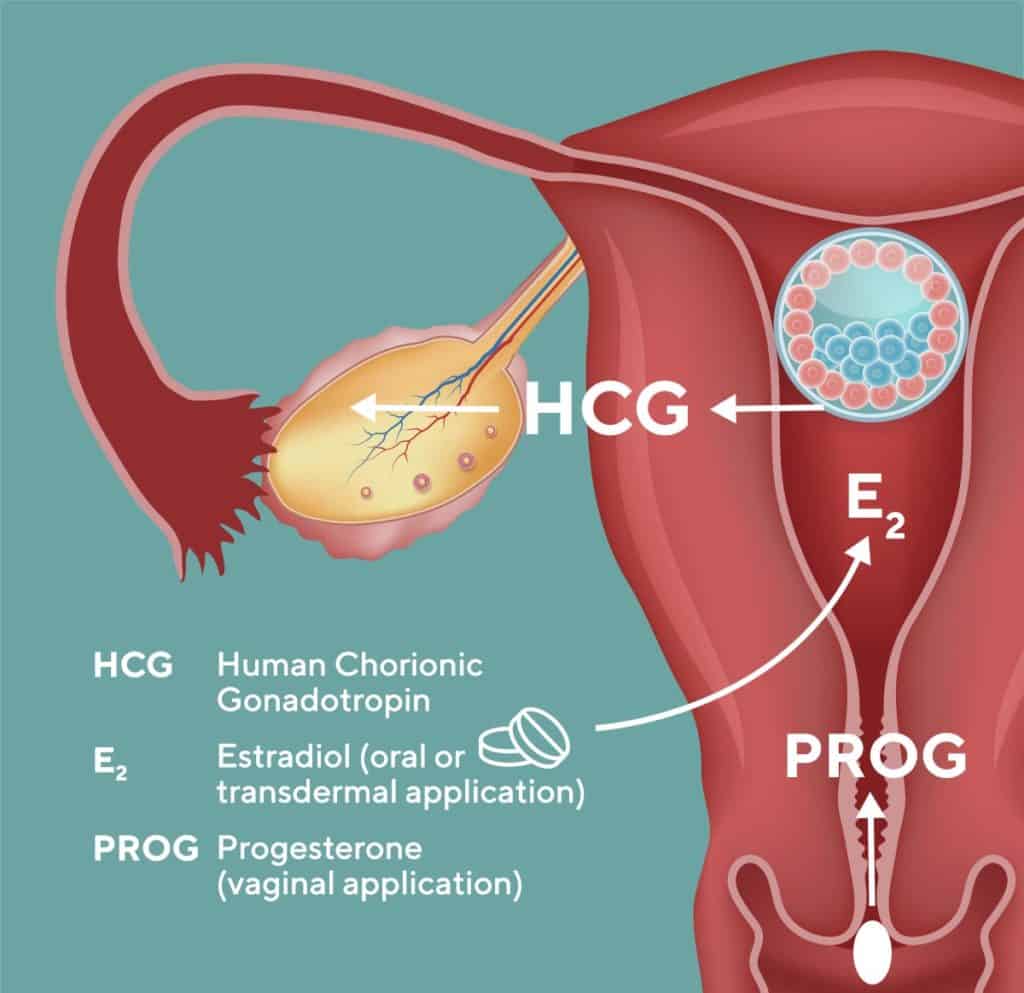
Possible bleeding in the first trimester after egg donation
Stable or growing estrogen and progesterone play a defining role in keeping endometrium in the uterus and delaying menstruation. If it happens that their levels decrease by more than 30%, a woman is likely to experience bleeding. This is the way uterus functions in case no conception has taken place or there was an early pregnancy loss. The environment inside the uterus is renewed through bleeding and soon the uterus is ready for new conceptions all over again and again — until it finally happens.
But there is a significant difference between bleeding in own egg pregnancy and in egg/embryo donation pregnancy:
Bleeding during an own egg pregnancy
Bleeding, if that happens during an own egg pregnancy achieved in “fresh cycle”, is a very warning sign meaning that primarily something is going wrong with the embryo. As the levels of estrogen and progesterone are responsible for keeping the endometrium in and postponing menstruation and they are in direct correlation with the HCG level, the bleeding indicates that the embryo stopped producing HCG, in other words, that it stopped developing. And, as a result, the uterus started cleaning itself through bleeding to get prepared for a new possibility of conception.
Pregnancy after egg donation or embryo adoption
In a pregnancy after egg donation or embryo adoption the embryo is not responsible for estrogen and progesterone production in the ovary because ovary is inactive and cannot respond to embryonic HCG stimulation. Instead women receive these two hormones from outside — as medication that they take on the regular basis according to their individual treatment plan. So the possible bleeding just tells us about the reduction in estrogen and progesterone levels in female body and doesn’t indicate a primary problem in embryonic development. Bleeding indicates that it is not enough medication in the body. By increase of medication under control of our medical team the bleeding stops and pregnancy continues.
Possible reasons for decrease of estrogen and progesterone levels (when taken as medication):
Not good absorption of the medication in the stomach because of:
- Food that one is not used to
- Changes in food intake regime
- Diarrhea
- Vomiting
Too quick destruction of the medication because of increased metabolism due to:
- Physical exercises
- Overheating (sauna, hamam)
- Intercourse
- Intensive life style
However, we understand that even the smallest bleeding is an alarming risk factor indicating that to preserve pregnancy our patient may need to increase the dosage of her hormonal medication. Also, the bleeding signs are off course extremely stressful and knock our patients off-balance. That is why we have developed a special medication scheme aimed at the most efficient stop of the bleeding in the shortest timeframe. And all our patients go through this scheme together with our nurse in advance at their consultation with her in our clinic in order to fully understand what they should do step-by-step and get all the questions answered.
But much more efficient than trying to stop the bleeding it is the prevention of bleeding.
Measures to reduce the risk of bleeding and miscarriage after egg donation
After the embryo transfer we strongly recommend our patients to switch to a relaxed lifestyle and to cut your usual physical activity so that you do not increase your metabolism and do not burn your medication to quick. Quicker destruction of medication before the next intake follows results in ups and downs of estrogen/progesterone levels in the body, which is a risk factor for bleeding. Until you reach the full 12 obstetrical week term of your pregnancy please abstain from activities which would increase your metabolism.
Since miscarriages in pregnancies after egg donation or embryo adoption mostly happen due to non-embryonic external reasons (drop in estrogen/progesterone concentration in your body), we need to make sure that the stable levels of these hormones are maintained permanently.
Here is our main advice on how to prevent the bleeding and hence the miscarriage:
- The intake of progesterone and estrogen should be done in different forms: orally, transdermally, vaginally and intramuscularly. This will ensure the best possible absorption and diversification of the ways the medication enters your body.
- Reduce your sport activities to the minimum as sport increases metabolism; consequently the medication in your body is destroyed before the next intake takes place.
- Eat healthy food and do not experiment with food you are not used to. Keep your diet normal and regular to prevent any indigestion issues.
- In case of diarrhea or vomiting, apply an additional estradiol patch and inform us so that we can guide you further. In case of indigestion, an oral intake of hormones can become inefficient that is why you can be recommended to use other ways more: transdermal, intramuscular, vaginal.
- Long stay in hot water speeds up the breakdown of hormones, so please, no saunas, hot baths or jacuzzis during the first trimester. But warm daily showers or a twenty-minute smooth swimming in a pool are totally fine.
- We advise abstaining from intercourse until you receive your pregnancy test result. If the test is positive and you do not have any pains or smear bleeds, you can go back to your normal sexual life.
- Even though after the 12th week of pregnancy the placenta starts producing hormones on its own and eliminates the hormonal differences between donor egg/embryo and own egg pregnancies, vaginal progesterone intake is prescribed until the thirty-second-week. This measure is intended to lengthen and strengthen the cervix and to reduce the risk of a late miscarriage or premature birth, especially in older patient groups.
Bearing the above recommendations in mind and staying in daily communication with our clinical team is the best way for you to stay confident and to ensure the normal development of your pregnancy after egg donation or embryo adoption.

